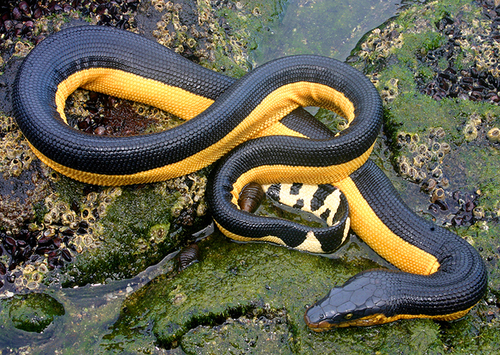
Yellow-bellied Sea Snake
The yellow-bellied sea snake, Hydrophis platurus, glides through tropical seas with its vivid yellow belly and dark top. A master swimmer with a paddle-like tail, it seldom visits land. This venomous snake plays a crucial role in marine ecosystems, preying on small fish.
2-7 years
Lifespan
Length: 91 - 122 cm
Size
High
Aggression
Least Concern
Conservation Status
Stable
Population Trend
Characteristics
The yellow-bellied sea snake, Hydrophis platurus, is known for its striking yellow underside and contrasting dark upper body. It inhabits warm tropical waters and is highly adapted to a pelagic lifestyle, rarely coming ashore. Notably, it possesses a paddle-like tail for efficient swimming and is venomous.
Distribution Range of the Yellow-bellied Sea Snake
Hydrophis platurus, commonly known as the yellow-bellied sea snake, is native to the tropical regions of the Indian and Pacific Oceans. Its geographical distribution includes the coastal waters of eastern Africa, the Arabian Sea, the Indian subcontinent, Southeast Asia, northern Australia, and the western coasts of the Americas, extending as far north as California and south to Peru.
Yellow-bellied Sea Snake's Habitat
Environmental Conditions
The yellow-bellied sea snake inhabits warm, tropical oceanic waters. It is primarily found in shallow coastal areas and estuaries but can occasionally be found in open ocean environments. The species prefers waters with temperatures ranging from 20°C to 30°C and is often associated with coral reefs, seagrass beds, and mangrove swamps.
Ecological Niche
Hydrophis platurus is a fully marine snake that plays a role as both predator and prey in its ecosystem. It primarily feeds on small fish, using its venom to immobilize them. As a pelagic species, it is well-adapted to life at sea, possessing specialized adaptations such as a flattened tail for swimming and the ability to exchange gases through its skin while submerged. This allows it to occupy an ecological niche as a mid-level predator in its marine environment.
Copyright @ Nature Style Limited. All Rights Reserved.
 English
English